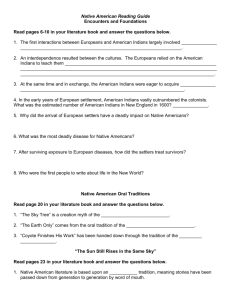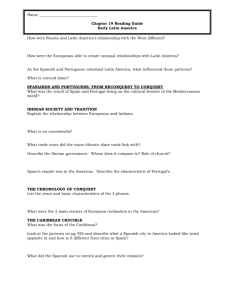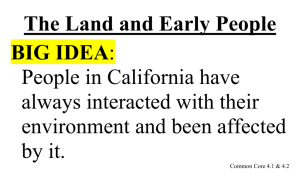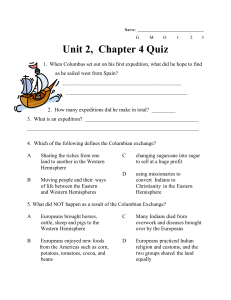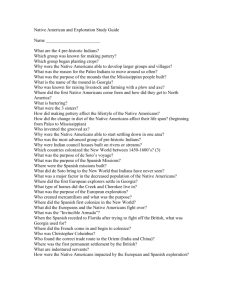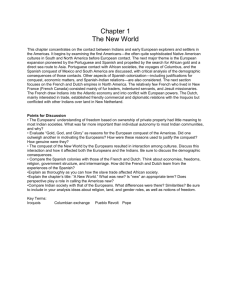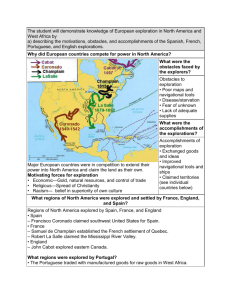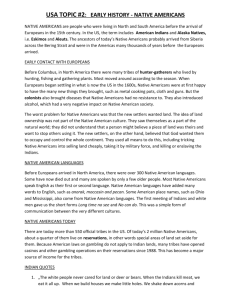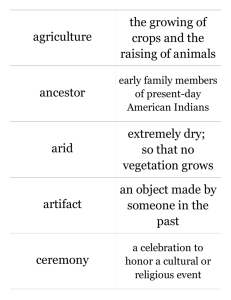AP US History Quiz Chapter 2 Name: Date/Period Questions 1
advertisement
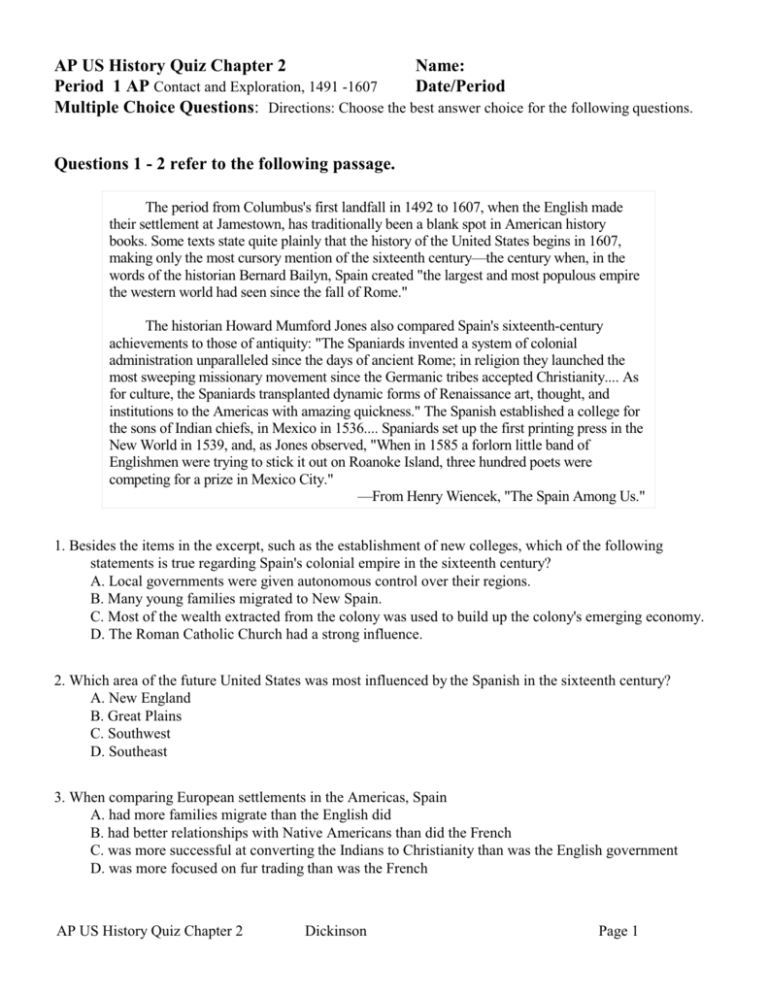
AP US History Quiz Chapter 2 Name: Period 1 AP Contact and Exploration, 1491 -1607 Date/Period Multiple Choice Questions: Directions: Choose the best answer choice for the following questions. Questions 1 - 2 refer to the following passage. The period from Columbus's first landfall in 1492 to 1607, when the English made their settlement at Jamestown, has traditionally been a blank spot in American history books. Some texts state quite plainly that the history of the United States begins in 1607, making only the most cursory mention of the sixteenth century—the century when, in the words of the historian Bernard Bailyn, Spain created "the largest and most populous empire the western world had seen since the fall of Rome." The historian Howard Mumford Jones also compared Spain's sixteenth-century achievements to those of antiquity: "The Spaniards invented a system of colonial administration unparalleled since the days of ancient Rome; in religion they launched the most sweeping missionary movement since the Germanic tribes accepted Christianity.... As for culture, the Spaniards transplanted dynamic forms of Renaissance art, thought, and institutions to the Americas with amazing quickness." The Spanish established a college for the sons of Indian chiefs, in Mexico in 1536.... Spaniards set up the first printing press in the New World in 1539, and, as Jones observed, "When in 1585 a forlorn little band of Englishmen were trying to stick it out on Roanoke Island, three hundred poets were competing for a prize in Mexico City." —From Henry Wiencek, "The Spain Among Us." 1. Besides the items in the excerpt, such as the establishment of new colleges, which of the following statements is true regarding Spain's colonial empire in the sixteenth century? A. Local governments were given autonomous control over their regions. B. Many young families migrated to New Spain. C. Most of the wealth extracted from the colony was used to build up the colony's emerging economy. D. The Roman Catholic Church had a strong influence. 2. Which area of the future United States was most influenced by the Spanish in the sixteenth century? A. New England B. Great Plains C. Southwest D. Southeast 3. When comparing European settlements in the Americas, Spain A. had more families migrate than the English did B. had better relationships with Native Americans than did the French C. was more successful at converting the Indians to Christianity than was the English government D. was more focused on fur trading than was the French AP US History Quiz Chapter 2 Dickinson Page 1 Questions 4 - 7 refer to the excerpt below. "Part of the myth about the first Americans is that all of them . . . had one culture . . . the white man turned everything upside down. Three elements were important in the early influence: the dislodgement of eastern tribes, the introduction of the horse, and metal tools and firearms. "The British invaders of the New World, and to lesser degree the French, came to colonize. They came in thousands to occupy the land. They were, therefore, in direct competition with the Indians and acted accordingly, despite their verbal adherence to fine principles of justice and fair dealing. The Spanish came quite frankly to conquer, to Christianize...They came in small numbers...and the Indian labor force was essential to their aims. Therefore they did not dislodge or exterminate the Indians.... "The Spanish, then did not set populations in motion. That was done chiefly from the east. The great Spanish contribution was the horse." --Oliver LaFarge, anthropologist, "Myths That Hide the American Indian,"The American Indian: Past and Present, 1971 4. Based on this excerpt, which of the following groups of colonists demonstrated the strongest desire to displace American Indians and take their land? A. Spanish B. British C. French D. Dutch 5. According to LaFarge, from their first arrival, the colonists with the greatest desire to see the American Indians survive and increase were which of the following? A. Spanish B. British C. French D. Dutch 6. Which of the following best describes something Europeans introduced in the Americas that helped American Indians survive colonization? A. European introduced new farming methods, which enabled American Indians to maintain their agricultural heritage B. Europeans introduced metal tools, which led to increased trade and better relationships with Europeans C. Europeans introduced horses, which transformed the cultures of American Indians on the Great Plains D. Europeans introduced Christianity, which brought unity among American Indians 7. Which of the following generalizations best describes a similarity among Europeans who colonized North America? A. All wanted to convert American Indians to Catholicism B. All emphasized developing extensive trade with American Indians C. All attempted to dominate American Indians in some way D. All intended to exterminate or remove American Indians AP US History Quiz Chapter 2 Dickinson Page 2 Questions 8-10 refer to the excerpt below. "Now we all found the loss of Captain Smith; yea, his greatest maligners could now curse his loss. As for corn provision and contribution from the savages, we had nothing but mortal wounds, with clubs and arrows.. . . "Nay, so great was our famine that a savage we slew and buried, the poorer sort took him up again and ate him; and so did diverse one another boiled and stewed with roots and herbs. . . . "This was that time, which still to this day, we called the starving time. It were to vile to say, and scarce to be believed, what we endured; but the occasion was our own for want of providence, industry, and government, and not the barrenness and defect of the country. . . . For till then in three years, for the numbers were landed us, we have never from England provision sufficient for six months." John Smith, Description of "starving time" in Virginia, 1607-1614 8. According to the excerpt, which of the following was the primary cause for the starving at Jamestown? A. Lack of control of the American Indians B. Lack of effort by the colonists C. Lack of support from England D. Lack of resources in the land 9. During the "starving time," the Jamestown colony depended on which of the following form of charter for its support? A. Joint-stock company B. Proprietary colony C. Royal colony D. Church-based company 10. The excerpt above suggests that the starving at Jamestown could have been avoided if A. American Indians had shared their food B. supply ships had arrived C. colonists had prayed harder D. Captain John Smith had been present in command AP US History Quiz Chapter 2 Dickinson Page 3 Questions 11–13 refer to the following excerpt: The Princes of Virginia ... wear the hair of their heads long. ... They wear a chain about their necks of pearls or beads of copper, which they much esteem.... They carry a quiver made of small rushes holding their bow ready bent in one hand, and an arrow in the other, ready to defend themselves. In this manner they go to war, or to their solemn feasts and banquets. They take much pleasure in hunting deer whereof there is great store in the country, for it is fruitful, pleasant, and full of good woods.... At a certain time of the year they make a great, and solemn feast whereunto their neighbors of the towns adjoining repair from all parts, every man attired in the most strange fashion.... Then being set in order they dance, sing, and use the strangest gestures. ... All this is done after the sun is set for avoiding of the heat.... —From Richard Hakluyt, The True Pictures and Fashions of the People in That Part of America Now Called Virginia, 1585. 11. Hakluyt, the author of the excerpt above, used stories of North America to create a "true picture" of the Indians. What was a direct result of Hakluyt’s description of the New World? A. England decided to put off establishing settlements in the New World for several decades. B. Royal charters were given to the Virginia Company and the Plymouth Company. C. The English challenged Spanish dominance in the New World by defeating the Spanish Armada. D. The first permanent settlement of Roanoke was established on the Outer Banks of North Carolina. 12. What factor contributed to England establishing settlements in the Americas later than other European nations? A. Disruptions in England caused by religious upheavals B. Fear of disturbing the peace England had established with Spain C. Focus on improving the country from within before establishing colonies D. Lack of resources and technology to support long distance exploration 13. Which of the following was true of Native Americans prior to the arrival of Europeans in the Americas? A. They had developed a large variety of cultures and languages. B. They were mostly members of small, hunter-gatherer groups. C. They lived in agricultural communities with a strong central government D. They built elaborate structures connected to their religious practices. AP US History Quiz Chapter 2 Dickinson Page 4

